Final Test Review C++ From Control Structures Through Objects
Essential Programming | Control Structures
The backbone of programs

If you want to start programming, I must admit that the outlook is not proficient: different operating systems, and so many programming languages, and endless ways of reaching the same results. These are the type of situations that will make you either run away (as fast and as far as you tin can, hoping you'll never bump into programming again), or face the creature. If you determine to face it, then yous won't know where to offset from, or how to handle it. Y'all'll only have questions and probably not even one answer, merely y'all know what? This is a great style to start. Really this is how I started programming. I believed that if I ever wanted to understand programs I had to respond the question of:
How do programs work, and how can you build them?
Certainly not a uncomplicated result, but come on, harder questions have been answered, right? Accept a wait at Marvin Minsky. Minsky, who is considered one of the fathers of AI, wrote "The Society of Mind" to reply ane of the most difficult questions of our time: what is the human mind, and how does it work? With a revolutionary perspective, Minsky suggested that our minds consist of the aggregation of small-minds (or more basic components) that accept evolved to perform highly specific tasks. Co-ordinate to him, well-nigh of these tiny-minds lack the attributes nosotros think of as intelligence and are severely limited, and can simply reach feelings, thoughts or purposeful action through the interaction with other components.
This thought contains a powerful concept: complex matters can be idea as groups of simpler subjects, that can too be partitioned into more bones things, until you reach a proper understanding. If you think near it this manner, whatsoever efficient system tin can be explained as a gear up of simpler functions that when put together perform in a way that reach superior results in comparison to their individual performances.
For this reason, if I wanted to sympathise reckoner programs (and larn how to make them) I needed to empathise their building blocks. You see, when a program runs, the code is read past the computer line past line (from top to bottom, and from left to right), just like you would read a volume. At some point, the program may reach a situation where information technology needs to brand a decision such as jump to a dissimilar office of the program or re-run a certain piece over again. These decisions that affect the flow of the program's code are known as a Control Structures.
Control Structures can be considered as the building blocks of computer programs. They are commands that enable a programme to "take decisions", post-obit one path or some other. A program is usually not limited to a linear sequence of instructions since during its process information technology may bifurcate, repeat code or featherbed sections. Command Structures are the blocks that analyze variables and choose directions in which to get based on given parameters.
The basic Control Structures in programming languages are:
- Conditionals (or Selection): which are used to execute ane or more statements if a condition is met.
- Loops (or Iteration): which purpose is to repeat a statement a sure number of times or while a condition is fulfilled.
Now allow'due south take a look at each 1 of these concepts. Downwards below we volition deep dive using R programming language (one of the mostly used languages for data science), but the same ideas and explanations utilise to any other programming linguistic communication.
Conditionals
"Conditionals" are at the very core of programming. The idea backside them is that they permit you to control the flow of the lawmaking that is executed based on dissimilar conditions in the programme (eastward.one thousand. an input taken from the user, or the internal country of the machine the program is running on). In this article nosotros will explore the Conditionals Control Structures of "If statements" and "If-Else statements".
i) If Statements
"If statements" execute one or more than statements when a condition is met. If the testing of that condition is TRUE, the argument gets executed. Merely if it's FALSE (the status is not met), then nothing happens. Let´due south visualize it:
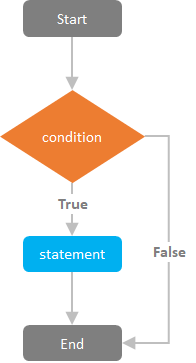
The syntax of "If statements" is:

Example
To testify a simple case, permit's say you lot want to verify if the value of a variable (x) is positive:

In this example, showtime we assign the value of 4 to the variable (ten) and use the "If statement" to verify if that value is equal or greater than 0. If the exam results TRUE (equally in this case), the function will print the sentence: "variable x is a positive number".
Output
[1] "variable x is a positive number" But since the "If statement" only executes a argument if the tested status is TRUE, what would had happened if the variable value was negative? To execute a statement on a tested status with a Faux result, we need to use "If-Else statement".
2) If-Else Statements
This Control Construction allows a plan to follow culling paths of execution, whether a condition is met or not.
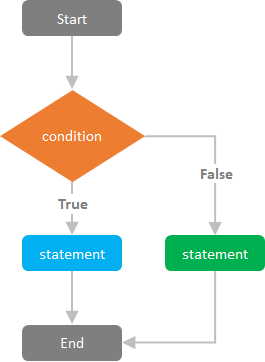
The syntax of "If-Else statements" is:

The "else role" of the education is optional and only evaluated if the condition tests Fake.
Case 1
Post-obit our example, nosotros extend the previous provisional "If statement" by adding the "else part" to examination if a the value of a variable is positive or negative and perform an activity whether the test consequence is Truthful or False.

In this example, we assign the value of -iv to the variable (ten) and utilise the "If argument" to verify if that value is equal or greater than 0. If the test results TRUE, the function will print the sentence: "variable x is a positive number". But in instance the examination results False (equally in this instance), the function continues to the culling expression and prints the sentence: "variable ten is a negative number".
Output
[1] "variable x is a negative number" Case ii
Let's say y'all demand to ascertain more than than 2 conditions, every bit in the effect of grading an exam. In that example you tin can grade A, B, C, D or F (v options), and then, how would you do it?
"If-Else statements" tin have multiple culling statements. In the below instance we define an initial score, and an "If-Else statement" of 5 rating categories. This piece of code will go through each status until reaching a TRUE test consequence.
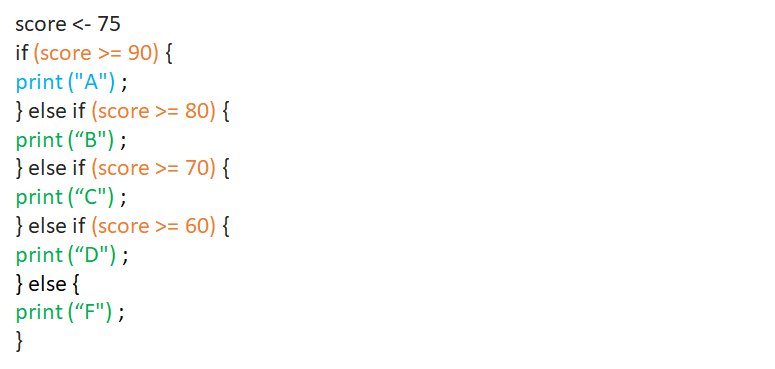
Output
[1] "C" Loops
"Loop statements" are nothing more than than the automation of multi-footstep processes past organizing sequences of actions, and grouping the parts that need to exist repeated. Likewise a fundamental function of programming, iteration (or Looping) gives computers much of their power. They can repeat a sequence of steps every bit often as necessary, and appropriate repetitions of uncomplicated steps tin solve complex problems.
In general terms, in that location are ii types of "Looping techniques":
- "For Loops": are the ones that execute for a prescribed number of times, every bit controlled by a counter or an alphabetize.
- "While Loops" and "Repeat Loops": are based on the onset and verification of a logical condition. The condition is tested at the start or the end of the loop construct.
Let's have a look at them:
one) For Loops
In this Control Structure, statements are executed i afterwards another in a sequent order over a sequence of values that gets evaluated only when the "For Loop" is initiated (never re-evaluated). In this example, the number of iterations is fixed and known in advance.

If the evaluation of the condition on a variable (which can assume values within a specified sequence) results TRUE, one or more than statements volition be executed sequentially over that string of values. Once the first condition examination is done (and results TRUE), the statement is executed and the status is evaluated again, going through an iterative process. The "variable in sequence" section performs this test on each value of the sequence until it covers the last chemical element.
If the condition is not met and the resulting outcome is FALSE (e.g. the "variable in sequence" part has finished going through all the elements of the sequence), the loop ends. If the status test results FALSE in the first iteration, the "For Loop" is never executed.
The syntax of "For Loops" is:

Example one
To show how "For Loops" work, get-go we will create a sequence by concatenating dissimilar names of fruits to create a list (called "fruit_list"):

We volition employ this fruit listing as the "sequence" in a"For Loop", and make the "For Loop" run a statement one time (print the name of each value) for each provided value in the sequence (the different fruits in the fruit listing):

This way, the outcome of the "For Loop" is as follows:
## [ane] "Apple"
## [1] "Kiwi"
## [ane] "Orange"
## [1] "Banana" OK, so we printed the proper noun of each value in the list. Not a large deal, right? The good thing is that "For Loops" can be used to produce more interesting results. Take a wait at the following example.
Example ii
What if nosotros want to modify values, or perform calculations sequentially? Yous can utilize "For Loops" to perform mathematical operations sequentially over each value of a vector (elements of the aforementioned blazon, which in this case volition be numerical).
In this example, nosotros will create a sequence of numbers (from 1 to ten), and set a "For Loop" to calculate and print the foursquare root of each value in that sequence:

In this case, the outcome of the "For Loop" is:
[1] one
[i] 1.414214
[ane] ane.732051
[1] 2
[1] 2.236068
[ane] 2.449490
[1] 2.645751
[i] 2.828427
[1] 3
[ane] three.162278 Y'all tin use any type of mathematical operator over a numerical sequence, and as we volition run across later in this commodity, make all sorts of combinations betwixt different Command Structures to reach more complex results.
2) While Loops
In "While Loops" a status is offset evaluated, and if the result of testing that condition is TRUE, one or more statements are repeatedly executed until that status becomes Imitation.
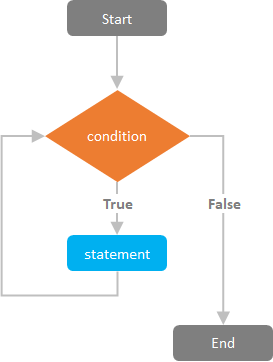
Dissimilar "If statements", in which a condition tested as True executes an expression but one time and ends, "While Loops" are iterative statements that execute some expression over and over again until the status becomes Simulated. If the condition never turns out to be FALSE, the "While Loop" will go on forever and the program will crash. The other style around, if the condition test results FALSE in the beginning of the loop, the expression will never get executed.
The syntax of "While Loops" is:

Case ane
Let'south see an example. First we will create a variable (x) and assign it the value of 1. Then we set a "While Loop" to iteratively test a status over that variable until the status test results Faux:

This is how it works: the initial value of the variable (x) is one, and then when we examination the condition "is the variable (x) less than 10?", the result evaluates to TRUE and the expression is executed, printing the effect of the variable (x), which in the start example is 1. But and then something happens: the variable (10) is incremented by 1 earlier the function ends, and in the next iteration the value of x will be two.
This variable reassignment is important because it will eventually reach the FALSE condition and the loop leave (value of x = 10). Declining to modify the initial conditions in a "While Loop" will consequence into an infinite loop and a plan crash.
Output
[one] 1
[1] two
[1] 3
[1] 4
[1] v
[one] 6
[1] 7
[1] eight
[one] ix Instance ii
Take you heard of the Fibonacci sequence? This is a series of numbers with the characteristic that the next number in the sequence is found past adding up the two numbers before information technology: 0, 1, 1, 2, 3, v, 8, thirteen, 21,… This sequence can be establish in several nature phenomena, and has dissimilar applications in finance, music, architecture, and other disciplines.
Permit's calculate it using a "While Loop".
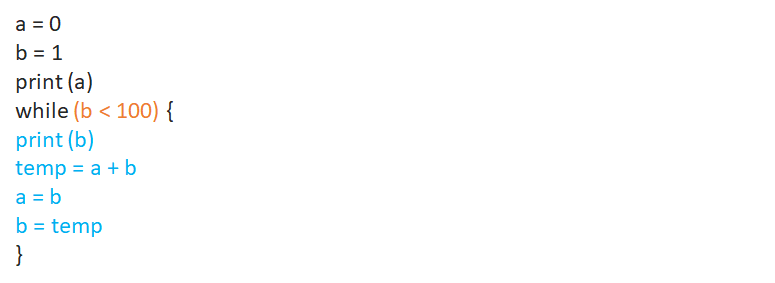
In this case we set a maximum value in the serial equally the terminate status, so that the loop prints the Fibonacci series simply for numbers below 100. When a series element (which e'er information technology is) becomes bigger than 100, the loop bike ends.
[1] 0
[1] ane
[1] i
[1] 2
[1] iii
[ane] v
[i] 8
[1] 13
[1] 21
[1] 34
[ane] 55
[1] 89 Instance three
Another way of generating the Fibonacci series with a "While Loop" is, instead of setting the maximum value of the series every bit a stop status, setting the number of series elements you want to generate.

This "While Loop" appends the next element of the series to the finish of the previous element, until reaching a stop condition. In this case, when the series reaches 10 elements (no matter which values), the loop cylce ends.
Output
[1] 0 1 ane two 3 5 viii thirteen 21 34 3) Echo Loops
Closely linked to "While Loops", "Repeat Loops" execute statements iteratively, but until a end condition is met. This way, statements are executed at to the lowest degree one time, no matter what the result of the status is, and the loop is exited only when certain condition becomes Truthful:
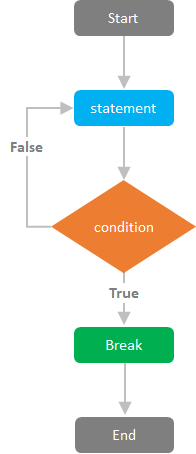
The syntax of "Echo Loops" is:

"Repeat Loops" employ "Break statements" every bit a cease condition. "Pause statements" are combined with the examination of a condition to interrupt cycles within loops, since when the program hits a break, it volition pass control to the education immediately later the stop of the loop (if any).
"Repeat Loops" will run forever if the pause condition is not met. Come across these 2 examples
Example 1
First we create a variable (ten) and assign it the value of 5. Then we set a "Repeat Loop" to iteratively impress the value of the variable, change the value of the variable (increase it by one), and test a condition over that variable (if it equals x) until the status examination results Truthful.

The "breaking status" triggers when the variable (x) reaches x, and the loop ends.
Output
[one] 5
[1] 6
[one] seven
[i] viii
[1] 9 Example ii
Now permit's suppose nosotros produce a list of random numbers, for which nosotros don't know the social club or sequence of generation.
In this example nosotros will use a "Repeat Loop" to generate a sequence of usually distributed random numbers (you can generate random with whatever other distribution, we just pick this one), and break the sequence once one of those numbers is bigger than 1. Since we don't know which numbers volition come first, nosotros don't know how long the sequence will be: we just know the breaking status.

Commencement, we utilise the "set.seed" pedagogy to fix the random numbers (generate always the same random numbers), and make this example reproduceable.
Then nosotros initiate the "Repeat Loop" past generating a normally distributed random number, printing information technology, and checking if that number is bigger than one. Merely when this condition becomes True (could be with the beginning generated number, or not), the loop bike will pass to the interruption argument and end.
Output
[1] -0.9619334
[1] -0.2925257
[one] 0.2587882
[1] -1.152132
[1] 0.1957828
[ane] 0.03012394
[i] 0.08541773
[1] 1.11661 This shows once again the importance of setting a proper breaking condition. Failing to do and then will result in an infinite loop.
Terminal Thoughts
We've seen and explained concepts in isolation, but "Control Structures" can exist combined anyway yous want: Loops may contain several internal Loops; Conditionals may contain Loops and Conditionals, the options are endless. (in fact, when reviewing "Repeat Loops" we found that the examples contained nested "If statements").
You tin can develop advanced solutions just by combining the "Control Structures" we explained in this commodity. Like Minsky stated, we can reach complex outcomes as a result of the interaction of simpler components. Control Structures institute the basic blocks for determination making processes in computing. They alter the flow of programs and enable u.s. to construct complex sets of instructions out of simpler edifice blocks.
My advice is: learn nearly them.
It will ease your path to coding and understanding of programs, and will help y'all to find new means of solving problems.
Source: https://towardsdatascience.com/essential-programming-control-structures-2e5e73285df4
0 Response to "Final Test Review C++ From Control Structures Through Objects"
Post a Comment